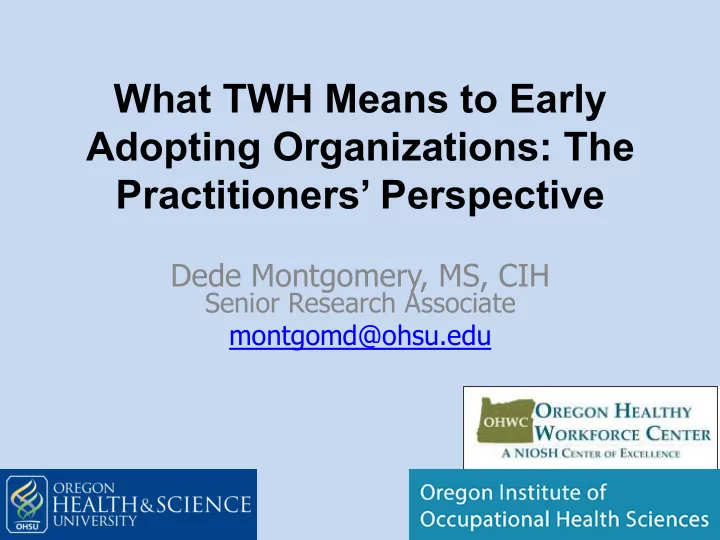

What TWH Means to Early Adopting Organizations: The Practitioners’ Perspective Dede Montgomery, MS, CIH Senior Research Associate montgomd@ohsu.edu
Industrial Hygiene Perspective Control ¡ An#cipa#on ¡ Chemical, ¡ Physical ¡or ¡ Biological ¡ Agent ¡ Evalua#on ¡ Recogni#on ¡
IH Perspective Engineering Control ¡ An#cipa#on ¡ & Admin controls Sedentary ¡ Work ¡ Evalua#on ¡ Recogni#on ¡ Job duties, Back, neck shift pain length
Safety & Health Management Systems h?ps://www.aiha.org/aihce07/handouts/po116palassis.pdf ¡ ¡
Integrated Management: Practitioners get it: silos create inefficiencies and holes Occupa#onal ¡ health ¡and ¡ Workplace ¡ safety ¡ Health ¡and ¡ health ¡ disability ¡ promo#on ¡ benefits ¡ Workers’ ¡ Return ¡to ¡work ¡ compensa#on ¡ Leadership ¡ commitment ¡ FMLA/OFLA, ¡ Employee ¡ and ¡suppor#ve ¡ ADA ¡ assistance ¡ work ¡ environment ¡
Disclaimer: The survey was collected from a convenience sample of regional stakeholders who have described their successes in integrating programs. Comments from Oregon practitioners who have been involved with integrating programs on TWH at various organizations are also included in this presentation.
TWH Survey • HR and OSH reps: construction, manufacturing, education, city government, public utility – Do you believe that it is important to integrate safety and health with wellness, or create TWH? Why or why not? – What have been your biggest successes in integrating health promotion with health protection (safety & health)? – What have been the greatest road blocks and biggest lessons you have learned from the steps you have taken to integrate wellness with safety and health? – What have you learned that you wish you knew before starting your efforts? – Can you identify two resources that you currently don’t have, that would make this effort easier?
Why Total Worker Health™? • Gain efficiency, synergy of effects & sustainability. • Employees that participate in educational & interactive activities tend to be healthier & more productive employees. • Fragmented programs cannot best address the whole person or achieve what is possible through combined effects. • It seems silly to have redundant programs & not use your already existing expertise. They affect each other & cannot be separated. • In absence of TWH, safety, health and wellness will never be more than patchwork quilt of programs.
Biggest Successes • Integrating site wellness & safety programs – partnerships between programs. • Integrating programs gained horsepower with organizational leadership. • Monthly meetings with senior management to discuss initiatives - programs to improve workforce wellness and safety. • Cross functional teams approaching prevention.
Biggest Successes • Increasing employee awareness that being healthy improves safety & productivity. • Increasing health knowledge of our employees. • Initiatives have been initiated from our safety committee ( fitness challenge, stress management training, non-violent communication, safety training integrating home hygiene practices ). We are not silo’ed and programs are seamless. Our goal is community – that’s the evidence we look for.
Biggest Lessons • Having a mobile workforce – communication difficult. • While we have management support, figuring out how to integrate on a functional level. • Measuring success - difficult to measure how efforts impact healthcare cost. Often measure success by worker involvement. • Our programs have been evolving naturally with management support & haven’t experienced roadblocks. • Perhaps more important than declared policy are managers that get it (integration) and will support it. • Being open to different ideas about how safety can support wellness, and vice versa. • Most health benefit leaders don’t understand what is meant by TWH.
Wish I’d known before.. • Where to get resources. • How difficult it is with a mobile workforce. • It’s not an overnight effort - it’s a journey shift from silos to integration. It requires patience, tenacity, commitment - sometimes faith from all members to begin to build bridges between programs. • How uneducated most people are with regard to health & wellness, including basic nutrition, how to find a doctor, using health benefits. • That others have these initiatives as well. Never heard the term “Total Worker Health” but apparently we have it without trying to.
Integration Examples • Joint safety & wellness • Info and training on safety committees outside of work, including commute • Joint assessments & inspections • Incentives for both safety and health initiatives and • Joint safety & wellness fairs activities and communications • On-site evaluation and • Family involvement in triage of pain or injury events and news whether work-related or not • Safety & wellness staff • Leave management function in same work group (small employers) • Work shift flexibility • Safety & wellness • Resources for child and departments plan and share elder-care and work-family regularly (larger employer) – conflict report to same executive • Selecting initiatives that build community
Indicators of Integration • Organizational leadership & commitment • Coordination between safety and wellness • Supportive organizational policies & practices – Processes for accountability & training – Coordinated management & employee engagement strategies – Benefits and incentives to support safety and wellness – Integrated evaluation and surveillance • Comprehensive program content Sorenson ¡et ¡al, ¡Integra#on ¡of ¡Health ¡Protec#on ¡and ¡Health ¡ Promo#on, ¡ACOEM ¡2013 ¡ ¡
What resources do you need? • Better knowledge about • Real-life examples – what initiatives work or this isn’t one-size fits are available. all. • Method to better • Medical and health- communicate with field based educational staff via email. materials. • We don’t know what we • Table of industry data don’t know – what counterparts/correlates. resources are really available? • Think tank – examples of what others are doing.
Follow us…. Follow us….
Recommend
More recommend